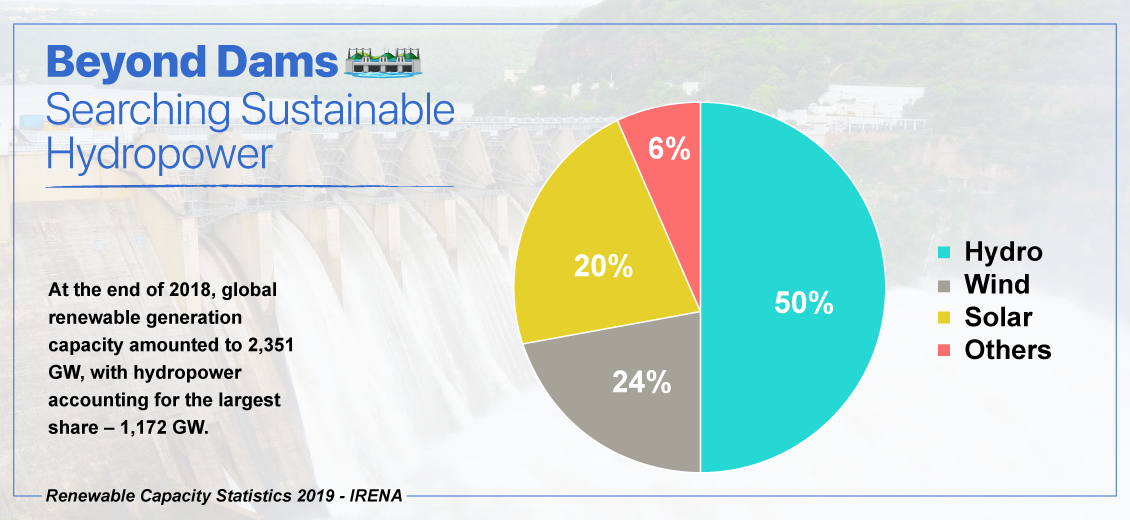Beyond Dams: Searching for Sustainable Hydropower
Blogs Home
- 13 Mar 2023

Conventionally, sustainable hydropower has been used across the world on a small scale to run water-wheel-based flour mills. The 18th century advancement in technical knowledge of hydraulic machines led to early hydropower-based energy. Further developments in harnessing electrical energy from water in the 19th century coupled with erstwhile growing energy demand for the industrial revolution paved the way for hydroelectric power and the 20th century, hydropower provisions emerged in the form of large dams and have since then been widely designated as clean energy.
In an impending climate crisis, hydro energy presented nations with a source of pollution-free renewable energy. It decreased the reliance on and purchase of greenhouse gas-emitting fossil fuels. The countries with hydroelectric potential soon developed and even over-exploited their capacity to generate hydroelectricity. However, with the increasing focus on the overall impacts of large dams, the west started decommissioning some of the major dams. In Europe alone, more than 200 dams were decommissioned in 2021. In the US nearly 1700 dams were dismantled in almost a century.
In developing nations however, hydroelectricity is still considered an attractive source of clean energy and lasrge dams like Three Gorges, Tehri dam and Itaipu dam have come to the rescue of China, India and Brazil to meet the rapidly growing energy demands as they try to climb up the development ladder. Now the question emerges: what led to removal of dams in the West?
Cons of Dams:
- Dams accumulate water in large reservoirs that alter the local ecology. The natural flow of the river is disrupted.
- Migration and spawning routes of fishes and other aquatic species are disturbed. High fish mortality is also associated with existing turbines.
- Proliferation of invasive species where new non-native fishes are introduced in reservoirs to boost fisheries.
- Huge environmental footprint: Loss of massive forest and arable lands under reservoirs occurs. The latest studies suggest that supposed green hydro energy is not so green as the submerged plants decay over time and produce harmful methane. Reservoir formation also leads to habitat fragmentation and loss of biodiversity.
- Social impact: Dams displace millions of people, often stripping away the culture of indigenous communities, who after several years continue to suffer from the lack of sense of belonging at new places.
- Landslide: Seasonal fluctuation in reservoir water results in landslides along reservoir rim. The slides also add to sedimentation of the reservoir.
- Flooding: Sometimes built to regulate frequent flooding of rivers, dams of late have become a source of amplified flooding with climate change-induced erratic rainfall becoming extreme events in higher mountain areas. Dam management releases huge amounts of water downstream, at times without warning. During the Kedarnath disaster (2013), Srinagar dam released water impounding the low-lying areas of town with debris. On another occasion Rishi Ganga dam broke down due to flash floods increasing the misery of both locals and administration.
- Economic viability: Cost of hydro infrastructure, rehabilitation and establishment of townships is very high.
As a native of Himalayan village, I often justified damification of Himalayan rivers in local debates and my own contemplations. I painted the veneer of infrastructure development (especially roads) in inaccessible Himalayan regions. Perhaps, it was biased by the languishing of a child to easily visit her ancestral home in remote Himalaya. By the time I finished my master's dissertation on Tehri dam, I was well aware of similar yearnings of displaced people, the only difference being that I had migrated by choice, and they were displaced without choice. The breaking of Rishi Ganga dam changed my perception of dams and brought to fore how in most of the world and particularly tectonically active fragile Himalayan terrain, these dams were not so green and sustainable.
Sustainable Hydropower
That apart from the several limitations of dams brings us to how then we can harness energy from water sustainably. Sustainable use of water resources means fulfilling the needs of the present without compromising the needs of future generations. The decrease in Salmon populations in Klamath river has called for proposals to dismantle (what will be the biggest to be removed) Iron Gate dam in the US. In India, high frequency of dams on rivers have threatened the existence of several freshwater species, including the majestic Ganga River dolphin.
Improvement in Existing Dam Sites
Providing better quality turbines that allow for fish movement is an important upgrade to make existing facilities more sustainable. Another way to increase their suitability is swapping infrastructure to more energy efficient categories. A third and much needed path is to create natural bypass fishways. Established prominently in dams of Canada, these allow for alternate pathways for fish, birds and mammals reinstating the natural ecosystems. Role of dams in amplification of disaster losses of climate induced disasters in India, particularly in Himalayan terrain indicates that sustainable hydropower lies in looking beyond dams.
Small run-of-river projects that do not involve reservoir formation escape several of the drawbacks associated with large reservoir-based dams. In the past such projects have largely followed diversion of water through tunnel technique. Despite returning the flow to river the construction of tunnels under mountains may lead to disasters like Joshimath Tapovan-Vishnugad project (a run-of-river project) reportedly pierced through aquifer, releasing substantial amounts of water ensuing subsidence of the township overtime. Sustainable run-of-river hydropower can be harnessed by putting floating buoys or mini hydropower plants directly into the river. The buoys are anchored at the bottom of the river and harness only kinetic energy of running water to provide electricity day and night. Emerging designs of such buoys have been installed on river Danube in Austria. The fish do not pass through such turbines, adding to the additional advantage of such setups.
Whirlpool turbines: Gravitational Water Vortex power plants tap inherent energy generated in a vortex. The turbine transforms rotational energy of water into electrical energy. It takes an inlet stream from the main channel and deposits water back to it. One such plant prototype was installed in the Ober-Grusendorf River in Austria. Such plants are very low impact and claim to have turbines that let fishes pass through without any harm.
New Avenues in Damless Hydropower
- Tidal power: Profitable tidal energy production is limited to places where the gap between high tide and low tide is at least 10 feet.
- Tidal turbines: The world's first commercial level tidal stream generator was installed in Strangford Lough, UK. MeyGen, Scotland happens to be the biggest submerged tidal turbine project in the world.
- Tidal fences: It refers to vertical axial turbines mounted on an array or fences on the seabed.
- Wave energy: Capturing tremendous wave energy has been made possible by on or below surface devices (like attenuator, point absorbers, pressure differential, oscillating wave energy converters) that are anchored at seabed. Prototype or fully operational plants are located across the world. Pelmis device in Portugal is an example of on surface installation CETO technologies have developed submerged devices set up on Australian shores.
- Ocean Thermal Energy Conversion technology utilizes the temperature difference between warm surface water of the ocean and cool deep ocean waters to produce electricity. The process requires a minimum temperature difference of 20 degree celsius. Such plants may have open, closed or hybrid cycles. Kona coast, Hawaii has this type of plant installation.
- Salinity Gradient based technologies are emerging to tap osmotic pressure of saline water into hydroelectricity. Another type of salinity gradient based technique uses reverse electrodialysis to generate power.
Conclusion
Certainly, the future of green hydropower generation lies in shifting focus towards innovative technology that is much less invasive to the environment, has a low impact on human counterparts and at the same time is cost-effective. But many of these remain costly as they are still in the stages of development and pilot testing. Making their manufacturing more economical will push to greater use of these devices. Some of the instream turbines, however, have half the building cost of traditional dams. Ocean-based hydropower certainly holds a promising future in switching to sustainability. A rigorous and continued effort to make safe turbine blades where these free-standing systems are supposed to encounter marine animals, like the case with axial turbines. Some of the models that do not let the animals pass through may be better options for both streams and oceans. A crucial way to keep new technologies relevant over time is upgrading equipment, recycling and real-time research.
The water calls,
For the free falls.
Tortoise, tigers and tribes fight,
Free flowing rivers are our right.
River weeps over artificial turbines,
Stop impounding in the name of 'white coal' mines.
Search for energy in new horizons,
Harness the power of moon tides and super Suns.
Look at the mighty Ocean,
Where hydro energy wonders are waiting to happen.
Sakshi Naithani
Sakshi has done her Masters in Geography from Delhi School of Economics, University of Delhi. She is currently pursuing Ph.D. in natural hazard risk assessment from Indian Institute of Remote Sensing-Kumaun University. When not engaged in research work, she loves to write poetry.
Blogs Home




